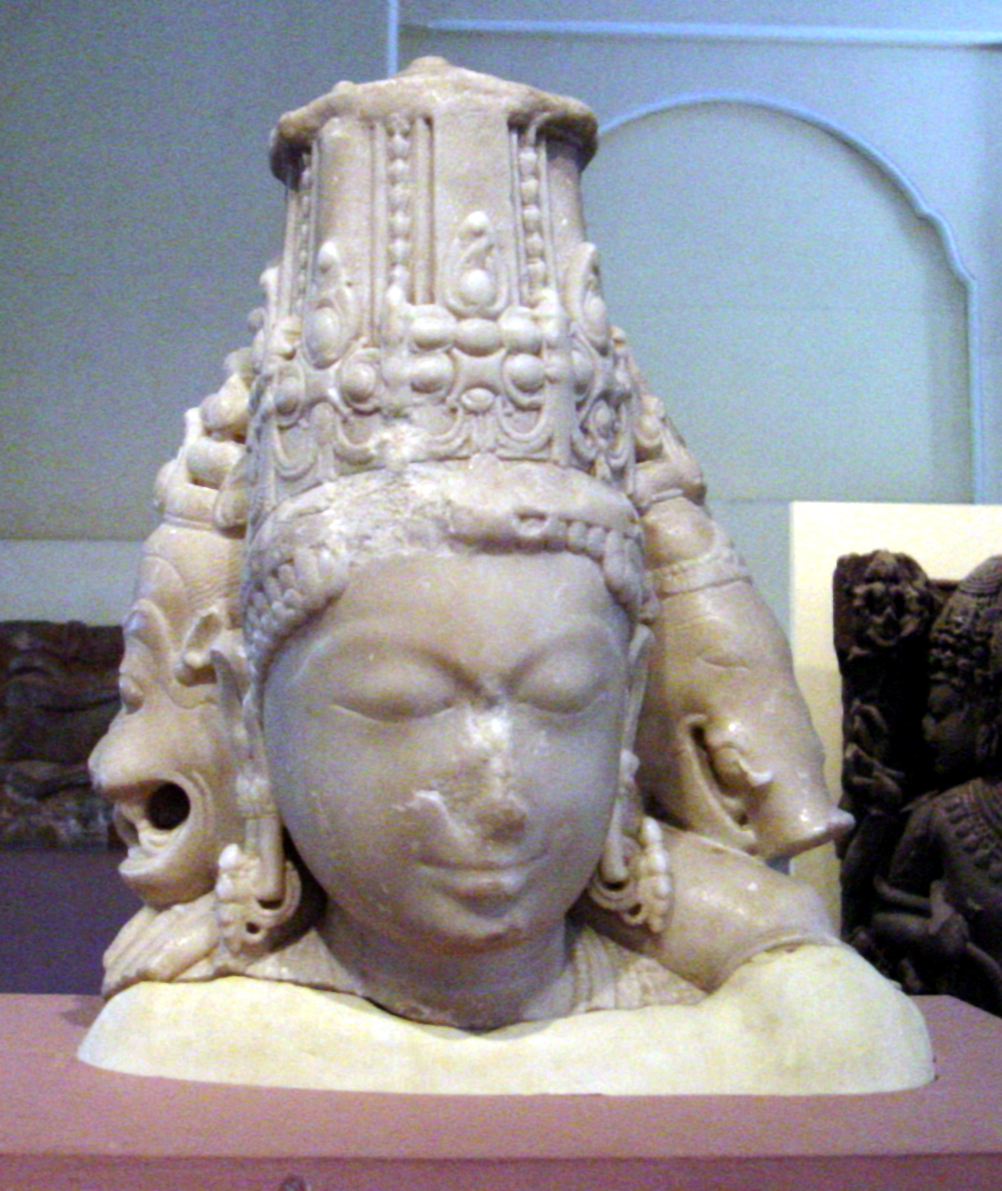|
Vaikuntha Chaturmurti
Vaikuntha Chaturmurti or Vaikuntha Vishnu is a four-headed aspect of the Hindu god Vishnu, mostly found in Kashmir (northern part of the Indian subcontinent). The icon represents Vishnu as the Supreme Being. He has a human head, a lion head, a boar head and a fierce head. Sometimes, even three-headed but aspects of Vishnu where the fierce rear head is dropped are considered to represent Vaikuntha Chaturmurti. Though iconographical treatises describe him to eight-armed, he is often depicted with four. Generally, Vaikuntha Chaturmurti is shown standing but sometimes he is depicted seated on his ''vahana'' (mount) Garuda. The concept of a four-headed Vishnu first appears in the Hindu epic ''Mahabharata'', but the complete iconography was first found in a 5th-century Pancharatra text. The icon reflects influences from the Gupta period and the Gandhara architectural tradition. While as per one interpretation, the animal heads represent Vishnu's avatar Narasimha (lion-headed man) and V ... [...More Info...] [...Related Items...] OR: [Wikipedia] [Google] [Baidu] |
Los Angeles County Museum Of Art
The Los Angeles County Museum of Art (LACMA) is an art museum located on Wilshire Boulevard in the Miracle Mile, Los Angeles, California, Miracle Mile vicinity of Los Angeles. LACMA is on Museum Row, adjacent to the La Brea Tar Pits (George C. Page Museum). LACMA was founded in 1961, splitting from the Los Angeles Museum of History, Science and Art. Four years later, it moved to the Wilshire Boulevard complex designed by William Pereira. The museum's wealth and collections grew in the 1980s, and it added several buildings beginning in that decade and continuing in subsequent decades. In 2020, four buildings on the campus were demolished to make way for a reconstructed facility designed by Peter Zumthor. His design drew strong community opposition and was lambasted by architectural critics and museum curators, who objected to its reduced gallery space, poor design, and exorbitant costs. LACMA is the list of largest art museums, largest art museum in the western United States. It a ... [...More Info...] [...Related Items...] OR: [Wikipedia] [Google] [Baidu] |
Aniruddha
Aniruddha ( sa, अनिरुद्ध ') is a character in Hindu mythology, the son of Pradyumna and Rukmavati, and the grandson of Krishna and Rukmini. He is said to have been very much like his grandfather, to the extent that he is considered by some to be a ''Jana avatar'', an avatar of Vishnu. He is a member of the chatur-vyuha, the four Vrishni heroes. Early life Anirudha was born to Pradyumna and Rukmavati. He was the grandson of Krishna and Rukmini. His mother Rukmavati was the daughter of Rukmi, the king of Vidarbha. He was also one of the few Maharathis (incredibly strong warriors) of his dynasty. His early life and marriage to his first wife, Rochana, are described in the Bhagavata Purana, Canto 10, Chapter 61. Marriages Marriage to Rochana Aniruddha's marriage to Rochana is described in the 61st Chapter of the 10th Canto of the Bhagavata Purana. At the behest of his sister Rukmini, Rukmi requested Krishna to have Aniruddha marry Rochana, after the wedd ... [...More Info...] [...Related Items...] OR: [Wikipedia] [Google] [Baidu] |
Pañcaratra
''Pancharatra'' (IAST: ''Pāñcarātra'') was a religious movement in Hinduism that originated in late 3rd-century BCE around the ideas of Narayana and the various avatars of Vishnu as their central deities.Pancharatra: religious movement Encyclopaedia Britannica The movement later merged with the ancient Bhagavata tradition and contributed to the development of . The Pancharatra movement created numerous literary treatises in Sanskrit called the ''Pancharatra Samhitas'', and these have been influential Agamic texts within the theistic ... [...More Info...] [...Related Items...] OR: [Wikipedia] [Google] [Baidu] |
Parabrahman
''Para Brahman'' ( sa, परब्रह्म, translit=parabrahma, translit-std=IAST) in Hindu philosophy is the "Supreme Brahman" that which is beyond all descriptions and conceptualisations. It is described as the formless (in the sense that it is devoid of Maya) that eternally pervades everything, everywhere in the universe and whatever is beyond. Param Brahma is conceptualised in diverse ways. In the Advaita Vedanta tradition, the Param Brahma is a synonym of ''nirguna brahman'', i.e., the attribute-less Absolute. Conversely, in Dvaita Vedanta and Vishistadvaita Vedanta traditions, the Param Brahma is defined as '' saguna brahman'', i.e., the Absolute with attributes. In Vaishnavism, Shaivism and Shaktism, Vishnu, Shiva and Adi Shakti respectively are Param Brahma. Mahaganapati is considered as Param Brahma by the Ganapatya sect. Kartikeya is considered as Param Brahma by the Kartikeya sect. Etymology ''Para'' is a Sanskrit word that means "higher" in some contexts, and ... [...More Info...] [...Related Items...] OR: [Wikipedia] [Google] [Baidu] |
Indra
Indra (; Sanskrit: इन्द्र) is the king of the devas (god-like deities) and Svarga (heaven) in Hindu mythology. He is associated with the sky, lightning, weather, thunder, storms, rains, river flows, and war. volumes/ref> Indra's myths and powers are similar to other Indo-European deities such as Jupiter, Perun, Perkūnas, Zalmoxis, Taranis, Zeus, and Thor, part of the greater Proto-Indo-European mythology. Indra is the most referred deity in the ''Rigveda''. He is celebrated for his powers, and as the one who killed the great evil (a malevolent type of asura) named Vritra, who obstructed human prosperity and happiness. Indra destroys Vritra and his "deceiving forces", and thereby brings rains and sunshine as the saviour of mankind. He is also an important deity worshipped by the Kalash people, indicating his prominence in ancient Hinduism. Indra's significance diminishes in the post-Vedic Indian literature, but he still plays an important role in various m ... [...More Info...] [...Related Items...] OR: [Wikipedia] [Google] [Baidu] |
Brahmanas
The Brahmanas (; Sanskrit: , ''Brāhmaṇam'') are Vedic śruti works attached to the Samhitas (hymns and mantras) of the Rig, Sama, Yajur, and Atharva Vedas. They are a secondary layer or classification of Sanskrit texts embedded within each Veda, which explain and instruct on the performance of Vedic rituals (in which the related Samhitas are recited). In addition to explaining the symbolism and meaning of the Samhitas, Brahmana literature also expounds scientific knowledge of the Vedic Period, including observational astronomy and, particularly in relation to altar construction, geometry. Divergent in nature, some Brahmanas also contain mystical and philosophical material that constitutes Aranyakas and Upanishads. Each Veda has one or more of its own Brahmanas, and each Brahmana is generally associated with a particular Shakha or Vedic school. Less than twenty Brahmanas are currently extant, as most have been lost or destroyed. Dating of the final codification of the ''B ... [...More Info...] [...Related Items...] OR: [Wikipedia] [Google] [Baidu] |
Upanishads
The Upanishads (; sa, उपनिषद् ) are late Vedic Sanskrit texts that supplied the basis of later Hindu philosophy.Wendy Doniger (1990), ''Textual Sources for the Study of Hinduism'', 1st Edition, University of Chicago Press, , pages 2-3; Quote: "The Upanishads supply the basis of later Hindu philosophy; they are widely known and quoted by most well-educated Hindus, and their central ideas have also become a part of the spiritual arsenal of rank-and-file Hindus." They are the most recent part of the Vedas, the oldest scriptures of Hinduism, and deal with meditation, philosophy, consciousness, and ontological knowledge; earlier parts of the Vedas deal with mantras, benedictions, rituals, ceremonies, and sacrifices.Gavin Flood (1996), ''An Introduction to Hinduism'', Cambridge University Press, , pp. 35–39A Bhattacharya (2006), ''Hindu Dharma: Introduction to Scriptures and Theology'', , pp. 8–14; George M. Williams (2003), Handbook of Hindu Mythology, Oxford Un ... [...More Info...] [...Related Items...] OR: [Wikipedia] [Google] [Baidu] |
Vedas
upright=1.2, The Vedas are ancient Sanskrit texts of Hinduism. Above: A page from the '' Atharvaveda''. The Vedas (, , ) are a large body of religious texts originating in ancient India. Composed in Vedic Sanskrit, the texts constitute the oldest layer of Sanskrit literature and the oldest scriptures of Hinduism. There are four Vedas: the Rigveda, the Yajurveda, the Samaveda and the Atharvaveda. Each Veda has four subdivisions – the Samhitas (mantras and benedictions), the Aranyakas (text on rituals, ceremonies, sacrifices and symbolic-sacrifices), the Brahmanas (commentaries on rituals, ceremonies and sacrifices), and the Upanishads (texts discussing meditation, philosophy and spiritual knowledge).Gavin Flood (1996), ''An Introduction to Hinduism'', Cambridge University Press, , pp. 35–39A Bhattacharya (2006), ''Hindu Dharma: Introduction to Scriptures and Theology'', , pp. 8–14; George M. Williams (2003), Handbook of Hindu Mythology, Oxford University Press, , p ... [...More Info...] [...Related Items...] OR: [Wikipedia] [Google] [Baidu] |
Puranas
Purana (; sa, , '; literally meaning "ancient, old"Merriam-Webster's Encyclopedia of Literature (1995 Edition), Article on Puranas, , page 915) is a vast genre of Indian literature about a wide range of topics, particularly about legends and other traditional lore. The Puranas are known for the intricate layers of symbolism depicted within their stories. Composed originally in Sanskrit and in Languages of India, other Indian languages,John Cort (1993), Purana Perennis: Reciprocity and Transformation in Hindu and Jaina Texts (Editor: Wendy Doniger), State University of New York Press, , pages 185-204 several of these texts are named after major Hindu gods such as Vishnu, Shiva, Brahma, and Adi Shakti. The Puranic genre of literature is found in both Hinduism and Jainism. The Puranic literature is encyclopedic, and it includes diverse topics such as cosmogony, cosmology, genealogies of gods, goddesses, kings, heroes, sages, and demigods, folk tales, pilgrimages, temples, medic ... [...More Info...] [...Related Items...] OR: [Wikipedia] [Google] [Baidu] |
Vaikuntha
Vaikuntha ( sa, वैकुण्ठ, lit=without anxiety, translit=Vaikuṇṭha), also called Vishnuloka (), and Tirunatu (Tirunāṭu) in Tamil, is the abode of Vishnu, the supreme deity in the Vaishnava tradition of Hinduism,Gavin Flood, An Introduction to Hinduism' (1996). and his consort, Lakshmi, the supreme goddess. According to Ramanuja, Vaikuntha is the ''Parama Padam'' or ''Nitya Vibhuti,'' an "eternal heavenly realm", and is the "divine imperishable world that is God's abode". In Vaishnava literature, Vaikuntha is described as the highest realm above the fourteen ''lokas'' (worlds), where the devotees of Vishnu go upon achieving liberation. It is guarded by the twin deities, Jaya and Vijaya, the gatekeepers of Vaikuntha. The army of Vishnu, stationed at Vaikuntha, is led by Vishvaksena. The planets of Vaikuntha are described to be full of golden palaces and hanging gardens that grow fragrant fruits and flowers. The planets of Vaikuntha begin 26,200,000 yojanas (209 ... [...More Info...] [...Related Items...] OR: [Wikipedia] [Google] [Baidu] |
Vishnudharmottara Purana
The Vishnudharmottara Purana (or the ''Vishnudharmottara'') is a Hindu Sanskrit text in the ''Upapuranas'' genre. Like the ''Mahapuranas'', it is also encyclopedic covering a wide range of secular and religious topics in the traditions of Hinduism. It is included in the list of eighteen Upapuranas given in the Brihaddharma Purana (1.25.23-26). History It is most celebrated for '' Chitrasutras'' constituting chapters 35–43 of the third ''khanda'' (book). This much cited part of the text dates from the Gupta period of Indian history. The ''Chitrasutra'' section of the ''Vishnudharmottara Purana'' has been discovered in manuscripts all over India and Nepal in Devanagari, Sharada, Bengali, and Newari scripts. The compilation that has survived into the modern age was likely complete by the 5th or 6th-century CE according to David Pingree. It is one of the oldest known complete Sanskrit treatises on painting arts in India. Content The ''Vishnudharmottara Purana'' is a Vaishna ... [...More Info...] [...Related Items...] OR: [Wikipedia] [Google] [Baidu] |
.jpg)



.jpg)

.png)


